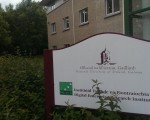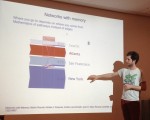Scientific report of the STSM at ISI Torino, 15-28.03.2014
In the last few years, the continuous development of ICT has led to a change of paradigm,
sometimes called Big Data, associated to a drastic increase in data collection methods and computing power. In the social sciences, it is now possible, for the first time, to track and analyze large-scale, time-resolved data in a variety of contexts, including communication and social networks, and mobility. The temporal nature of the data leads to methodological challenges in order to uncover significant temporal information and, more generally, to understand the effect of temporality on networked systems. Important areas of application include epidemiology, knowledge diffusion, rumor spreading, etc..
The main purpose of this STSM at ISI Torino was to trigger connections between ongoing
projects at ISI and in the group I work in (Complexity and Networks group in UNamur). In this sense, my STSM has been successful as several points, detailed below, have been identified for future collaborations.
- Researchers at ISI have recently proposed a new method [1] for community detection in temporal networks [2] based on tensor techniques. In Namur, I have recently taken part in the creation of a new method based on a use of memory networks [3] (non-Markovian systems), but it has only been tested on artificial data so far. I have started comparing both approach, and have applied our method to empirical data provided by ISI.
- Ciro Cattuto has a set of publications ([5], [6], etc) about tag similarity and more generally about information dynamics. I have presented our recent work about similarity measures, which take into account non-local system structure, which could be used to improve our understanding of knowledge diffusion in the near future.
- During this STSM we have also exchanged practices about software and hardware techniques in order to retrieve and analyze data on human mobility. As we work on different temporal and spatial scales, a combination of our datasets could be used for multi-scale models.
- A group in ISI has built a theory of temporal homology applications to the network science. We are currently applying their techniques to a dataset I have in order to better understand how scientific collaborations are built.
From my point of view, the STSM was successful and extremely useful, because it has opened
me doors to collaborations in other fields of research and it has been a source of inspiration for ongoing projects.
References
[1] Laetitia Gauvin, André Panisson, Ciro Cattuto, “Detecting the Community Structure and
Activity Patterns of Temporal Networks: A Non-Negative Tensor Factorization Approach”,
Plos One, DOI: 10.1371/journal.pone.0086028
[2] P. Holme, J. Saramaki, “Temporal Networks”, Phys. Rep. 519, 97-125 (2012)
[3] M. Rosvall, A. V. Esquivel, A. Lancichinetti, J. D. West, R. Lambiotte, “Martin Rosvall,
Alcides V. Esquivel, Andrea Lancichinetti, Jevin D. West, Renaud Lambiotte”. arXiv:1305.4807
[4] G. Palla, I. Derenyi, I. Farkas, T. Vicsek, “Uncovering the overlapping community structure of complex networks in nature and society”, Nature 435 (2005) 814-818.
[5] Benjamin Markines, Dominik Benz, Ciro Cattuto, Filippo Menczer, Andreas Hotho, Gerd
Stumme, “Evaluating Similarity Measures for Emergent Semantics of Social Tagging”,
WWW ’09 Proceedings of the 18th international conference on World wide web, Pages
641-650
[6] Ciro Cattuto, Dominik Benz, Andreas Hotho, Gerd Stumme “Semantic Grounding of Tag
Relatedness in Social Bookmarking Systems”, ISWC ’08 Proceedings of the 7th International
Conference on The Semantic Web, Pages 615-631
Vsevolod Salnikov





